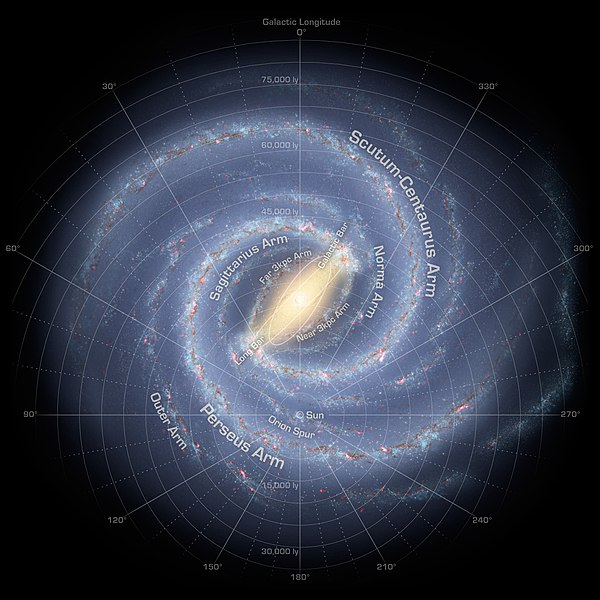Wow, a couple of gorgeous shots from the NASA Astronomy Picture of the Day. After that are a couple more shots from NASA. Yesterday's, taken from atop Mauna Kea on Hawaii, high above most of the Earth's atmosphere:

Click the image to see the story.
And from last September, a mosaic taken in Canyonlands National Park, eastern Utah:

Click the image to see the story.
The Milky Way is the most-visible portion of our Milky Way Galaxy, recently identified as a barred-spiral type (see photo, below). We live within a small, partial arm called the Orion Arm, between the Sagittarius and Perseus Arms. This is about 2/3 of the way out from the core, so what we call "the Milky Way" is the disk of the galaxy; when we look inward toward the densest region, near the constellation Sagittarius, we're looking toward the galactic core. In the opposite direction of the core lies the outer Perseus Arm, while above and below the band of the Milky Way is the relative emptiness of intergalactic space. This next photo is a great map of the Milky Way Galaxy looking down from above, annotated with names of the spiral arms:

Click the image to see details about the spiral arms in our galaxy and to find a much-larger version of the image.
The Milky Way Galaxy is about 100,000 light-years across, 1,000 light-years thick, and contains between 200-400 billion stars. It takes our Solar System 220 million years to orbit the core. Wow, think about those numbers for a moment, then check out this great panorama of our view of this awesome domain:

Click the image to see a much-bigger version.
When I was young, I used to live in places where I could look up and see such glory. After looking at these photos, I need a vacation to a dark place.
Best,
Chris

Click the image to see the story.
And from last September, a mosaic taken in Canyonlands National Park, eastern Utah:

Click the image to see the story.
The Milky Way is the most-visible portion of our Milky Way Galaxy, recently identified as a barred-spiral type (see photo, below). We live within a small, partial arm called the Orion Arm, between the Sagittarius and Perseus Arms. This is about 2/3 of the way out from the core, so what we call "the Milky Way" is the disk of the galaxy; when we look inward toward the densest region, near the constellation Sagittarius, we're looking toward the galactic core. In the opposite direction of the core lies the outer Perseus Arm, while above and below the band of the Milky Way is the relative emptiness of intergalactic space. This next photo is a great map of the Milky Way Galaxy looking down from above, annotated with names of the spiral arms:

Click the image to see details about the spiral arms in our galaxy and to find a much-larger version of the image.
The Milky Way Galaxy is about 100,000 light-years across, 1,000 light-years thick, and contains between 200-400 billion stars. It takes our Solar System 220 million years to orbit the core. Wow, think about those numbers for a moment, then check out this great panorama of our view of this awesome domain:

Click the image to see a much-bigger version.
When I was young, I used to live in places where I could look up and see such glory. After looking at these photos, I need a vacation to a dark place.
Best,
Chris
Tags:
From:
no subject
From:
no subject
From:
no subject
(And no one can see the Milky Way quite this dramatically with naked eyes. You need light collection over time or with bigger objectives.)
From:
no subject
I want my moon base.